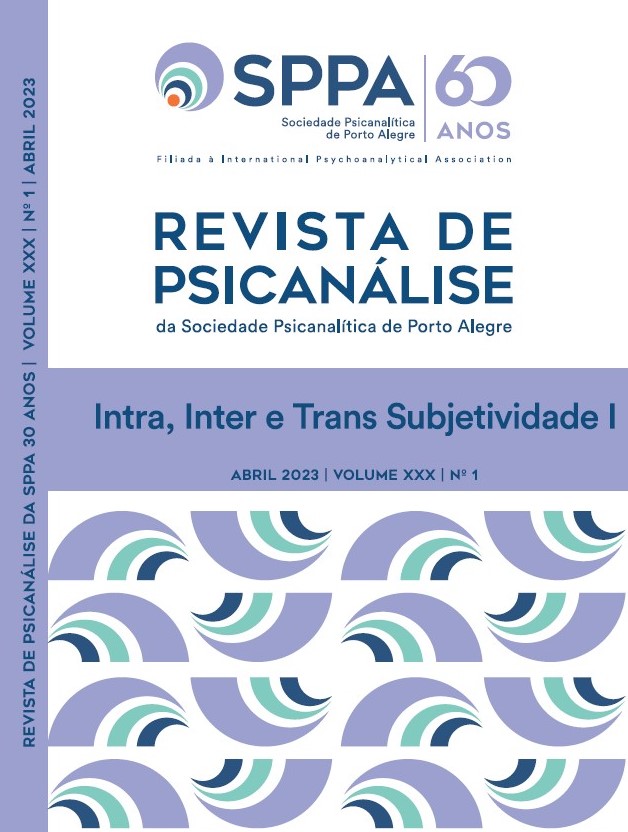Intersubjective phenomena and communication in analysis: a clinicaltheoretical essay
Keywords:
Intersubjectivity, Countertransference, Reverie, Corporeality, SymbolizationAbstract
This article presents interspersed fragments of a clinical case and a brief history of technical and conceptual modifications related to intersubjective phenomena in psychoanalysis. Countertransference, reverie, and the analyst’s own psychic functioning are highlighted, understanding them as important events for communication in psychoanalytical practice. To this end, the ideas of André Green, Thomas Ogden, Michel De M’Uzan and Giuseppe Civitarese are discussed, among other authors of contemporary psychoanalysis. The intrapsychic and intersubjective aspects of care connect and give voice to the psychological chimera (M’Uzan, 1978 and 1994), the analytic third (Ogden, 1994), the somatic reverie (Civitarese, 2016), and the corporeal effects of verbal and nonverbal communication (Civitarese, 2010, 2016 and Coelho Junior, 2010). The essay also seeks to understand and conceptualize the psychic paths (including the corporeal, imagery, affective, protosymbolic and symbolic levels) of the work of “digestion” and comprehension of this experience. The essay follows the complex elaboration – conscious and unconscious, verbal and nonverbal – that results in the transformation of the reverie into symbolic elements and their communication to the analysand.
Downloads
References
Azevedo, A.M. & Rolland, J.C. (2010). Représentation psychique et travail de figurabilité chez l’analyste. Revue Française de Psychanalyse, 74(2), 467-481.
Baranger, M & Baranger, W. (2010). A situação analítica como um campo dinâmico. In Livro anual de psicanálise, (Vol. 24, pp. 187-214). (Trabalho original publicado em 1961/1962)
Bion, W.R. (1962). Learning from experience. London: Heinemann.
Bion, W.R (1967). A theory of thinking. In Second thoughts, (pp. 110-119). New York: Jason Aronson. (Trabalho original publicado em 1962)
Busch, F. (2018). Searching for the analyst’s reveries. The International Journal of Psychoanalysis, 99(3), 569-589.
Busch, F. (2019). The analist’s reveries, explorations in bion’s enigmatic concept. London/New York: Routledge.
Cassorla, R.M.S (2016). O que acontece antes e depois do enactment agudo: validando fatos clínicos. In O psicanalista, o teatro dos sonhos e a clínica do “enactment”, (pp. 175‑210). São Paulo: Blucher.
Civitarese, G. (2010). The intimate room: theory and technique off the analytic field. London/New York: Routledge.
Civitarese, G. (2016). Truth and the unconscious in psychoanalysis. London/New York: Routledge.
Coelho Junior, N.E. (2010). Da intercorporeidade à co-corporeidade: elementos para uma clínica psicanalítica. Revista Brasileira de Psicanálise, 44(1), 51-60.
Coelho Junior, N.E. (2016). The origins and destinies of the idea of thirdness in contemporary psychoanalysis. The International Journal of Psychoanalysis, 97(4), 1105-1127.
Dispaux, M-F. (2002). Aux sources de l’interpretation. Revue Française de Psychanalyse, 66 (numero spécial du Congrès “Transformations psychiques”), 1461-1496.
Donnet, J-L. (2005). Entre l’agir et la parole. In La situation analysante. Paris: PUF.
Ferenczi, S. (1990) Análise mútua e limites de sua aplicação. In Diário clínico, (pp. 41-44). São Paulo: Martins Fontes. (Trabalho original publicado em 1932)
Ferro, A. (2005). A auto-análise e os gradientes de funcionamento do analista. In Fatores de doença, fatores de cura: gênese do sofrimento e da cura psicanalítica. (pp. 129-141). Rio de Janeiro: Imago.
Figueiredo, L.C. (2009). As diversas faces do cuidar: novos ensaios de psicanálise contemporânea. São Paulo: Escuta.
Figueiredo, L.C. & Coelho Junior, N.E. (2018). Adoecimentos psíquicos e estratégias de cura: matrizes e modelos em psicanálise. São Paulo: Blucher.
Freud, S. (2010). O inquietante. In Freud, S. Obras completas, (Vol. 14, pp. 328–376). São Paulo: Companhia das Letras, 2010. (Trabalho original publicado em 1919)
Freud, S. (2010). Além do princípio do prazer. In Freud, S. Obras completas, (Vol. 14, pp. 161-239). São Paulo: Companhia das Letras. (Trabalho original publicado em 1920)
Giampieri-Deutsch, P. (1996). The influence of Ferenczi’s ideas on contemporary standard technique. In Ferenczi’s turn in psychoanalysis, (pp. 224-247). New York/ London: New York University Press.
Godfrind, J. & Haber, M. (2002). L’expérience agie partagée. Revue Française de Psychanalyse, 64(5), 1417-1460.
Green, A. (1990). L’analyste, la symbolisation et l’absence. In La folie privée, (pp. 73-119). Paris: Gallimard. (Trabalho original publicado em 1974)
Green, A. (2002). Idées directrices pour une psychanalyse contemporaine. Paris: PUF.
Ithier, B. (2016). The arms of the Chimeras. The International Journal of Psychoanalysis, 97(2), 451-478.
Martini, A. e Coelho Junior, N.E. (2019). O sentimento de si e o estranho. Revista Brasileira de Psicanálise, 53(1), 195-212.
M’Uzan, M. (2019). Contratransferência e sistema paradoxal. In Da arte à morte: itinerário psicanalítico, (Tradução de Fabio Landa, pp. 157-173). São Paulo: Perspectiva. (Trabalho original publicado em 1976)
M’Uzan, M. (1978). La bouche de l’inconscient. Nouvelle Revue de Psychanalyse, 17, 89-97.
M’Uzan, M. (1994). Pendant la séance: considérations sur le fonctionnement mental de l’analyste. In La bouche de l’inconscient, (pp. 45-68). Paris: Gallimard. (Trabalho original publicado em 1989)
Ogden, T.H. (1989). The primitive edge of experience. London: Jason Aronson Inc.
Ogden, T.H. (1994). Subjects of analysis. London: Jason Aronson Inc.
Ogden, T.H. (1997). Reverie and interpretation: sensing something human. New Jersey: Jason Aroson Inc.
Ogden, T.H. (2008). What’s true and whose idea was it. The International Journal of Psychoanalysis, 84(3), 593-606.
Reis, B. (2016). Monsters, dreams and madness: commentary on “the arms of the chimeras”. The International Journal of Psychoanalysis, 97(2), 479-488.
Reis, B. (2020). Creative repetition. In Creative repetition and inter subjectivity: contemporary Freudian explorations of trauma, memory, and clinical process. London/New York: Routledge.
Rocha Barros, E.M. & Rocha Barros, E.L. (2019). Uma ri-fondazione del concetto di controtransfert: reverie. Rivista Psicoanalisi, 65(3), 595-614.
Swift, J. (1801). A modest proposal. For preventing the children of poor Ireland, from being a burden on their parents or country, and for making them beneficial to the public. In The works of the rev. Jonathan Swift, D.D., dean of St. Patrick’s of Dublin. (Vol. 9). London:
H. Baldwin and Son. (Trabalho original publicado em 1729)
Winnicott, D.W. (1984). Hate in the countertransference. In Through paediatrics to psychoanalysis, (pp. 194-203). London: Karnac. (Trabalho original publicado em 1947)
Winnicott, D.W. (1984). Clinical varieties of transference. In Through paediatrics to psychoanalysis, (pp. 295-299). London: Karnac. (Trabalho original publicado em 1955)
Published
How to Cite
Issue
Section
License

This work is licensed under a Creative Commons Attribution-NonCommercial-NoDerivatives 4.0 International License.
Atribuo os direitos autorais que pertencem a mim, sobre o presente trabalho, à SPPA, que poderá utilizá-lo e publicá-lo pelos meios que julgar apropriados, inclusive na Internet ou em qualquer outro processamento de computador.
I attribute the copyrights that belong to me, on this work, to SPPA, which may use and publish it by the means it deems appropriate, including on the Internet or in any other computer processing.
Atribuyo los derechos de autor que me pertenecen, sobre este trabajo, a SPPA, que podrá utilizarlo y publicarlo por los medios que considere oportunos, incluso en Internet o en cualquier otro tratamiento informático.










